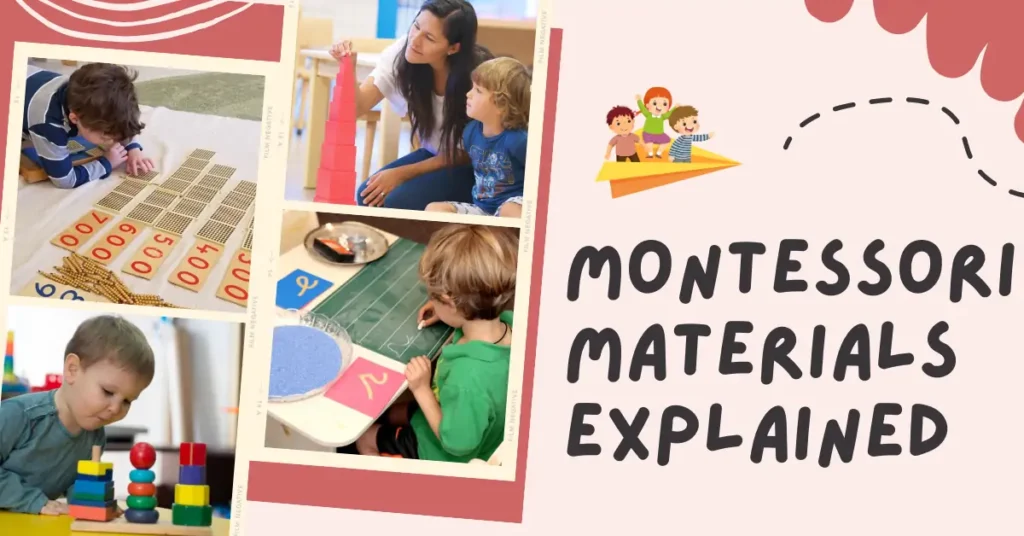Welcome to the comprehensive guide to classic Montessori materials. Whether you’re a teacher, parent, or just curious about the Montessori method, this article is your one-stop resource for understanding and utilizing classic Montessori materials.
Classic Montessori materials are not ordinary learning materials. They have been carefully designed and developed according to the philosophy of influential educator Maria Montessori. By engaging children in hands-on learning experiences, these materials foster independence, critical thinking, and the development of various skills. Montessori education is known for its hands-on approach and emphasis on self-directed learning. At the center of this approach are Montessori materials.
In this guide, we’ll explore classic Montessori materials, their purpose, their use at different ages, and how they support children’s development across all domains, including math, language, sensory, and real-life skills. From the iconic pink tower and moveable alphabet to gold beads and red rods, each material has a specific purpose that engages children’s senses, develops attention, and promotes independent problem-solving. Learn about the unique benefits of each material and how to incorporate them into your Montessori learning environment effectively.
What Are Montessori Materials?
Montessori materials are specialized educational tools that provide children with sensory and refined skill-building experiences corresponding to their developmental stage. These materials range from simple objects such as wooden blocks to more complex items such as beaded chains and cylinders. Each piece is carefully crafted to help develop cognitive and motor skills through active, self-directed learning. This design concept allows children to learn to manipulate objects and understand abstract concepts such as size, numbers, shapes and colors.
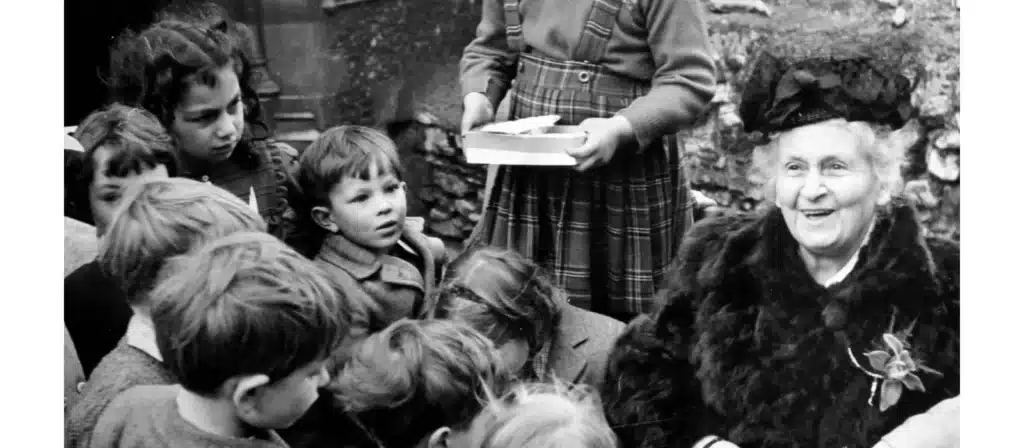
Using these materials in classrooms is carefully structured, with children introduced to progressively more complex tasks as their understanding deepens. This pedagogical approach is grounded in Maria Montessori’s educational theory, which emphasizes learning through interaction with the environment, fostering independence and a natural curiosity about the world.
Understanding the Montessori Philosophy Behind Material Selection
The Montessori philosophy is based on the belief that education should cater to each child’s mental and physical growth. This philosophy asserts that children learn best in a prepared environment supporting natural development. To achieve this, Montessori materials are designed for learning specific skills and encouraging harmonious and comprehensive development.
Each Montessori material has a dual purpose: to teach a specific educational concept and to enhance developmental traits such as sensory perception or problem-solving abilities. The selection and use of these materials are guided by the observation of children, with educators adjusting the learning environment according to each student’s individual needs and pace.
What Are the Characteristics of Classic Montessori Materials?
Several key characteristics distinguish classic Montessori materials:
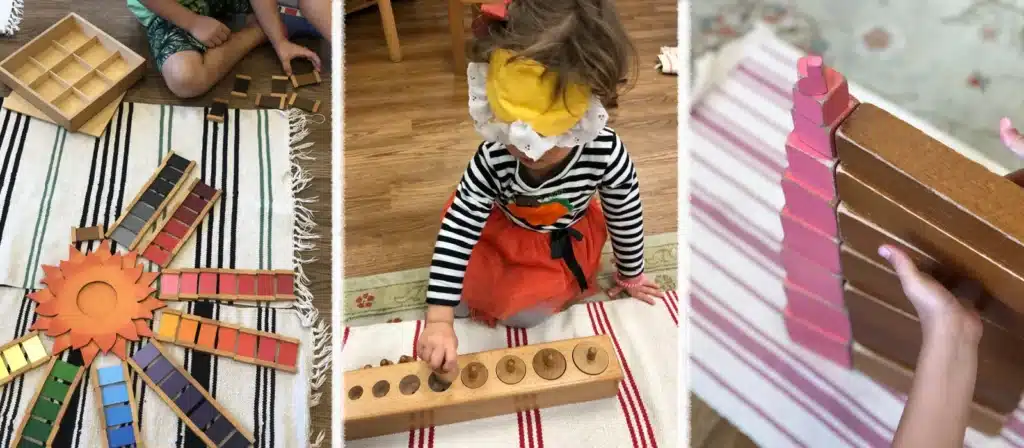
- Sensory-based learning: The materials stimulate and refine the senses, helping children build knowledge through touch, sight, and manipulation.
- Self-correcting: Each material typically offers immediate feedback about its use, which teaches children to perceive and correct their errors independently.
- Reality-oriented: They reflect real-life items and scenarios, which help children understand and navigate the world around them.
- Isolation of difficulty: Each material focuses on one skill or concept at a time to avoid confusion and help the child build confidence and competence.
- Aesthetic and durable: Materials are made from high-quality, natural substances such as wood, metal, and glass, appealing to the child’s sense of beauty and designed to withstand years of use.
These characteristics ensure that children are not just passively receiving information but actively actively exploring their environment, which is central to the Montessori method.
6 Classic Montessori Material Types
Montessori materials can be categorized into several types, each corresponding to different areas of learning:
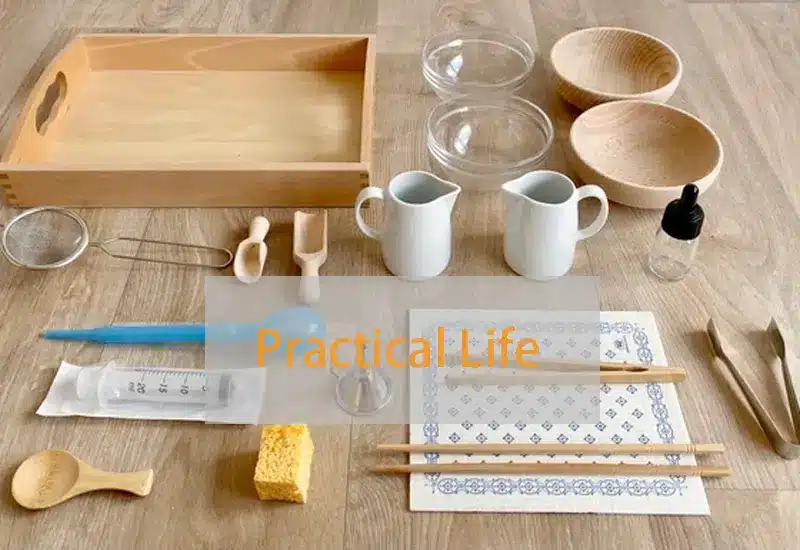
Practical Life
These materials, such as pouring water or scooping grains, teach daily living skills while fostering children’s concern for themselves, others, and the environment and enhancing fine motor skills and coordination.
Sensorial
Enhancing young children’s senses helps them understand the many nuances of their environment. Children learn to categorize their surroundings based on height, weight, colors, sounds, smells, and shapes using pink towers, colorful tablets, or speakers.
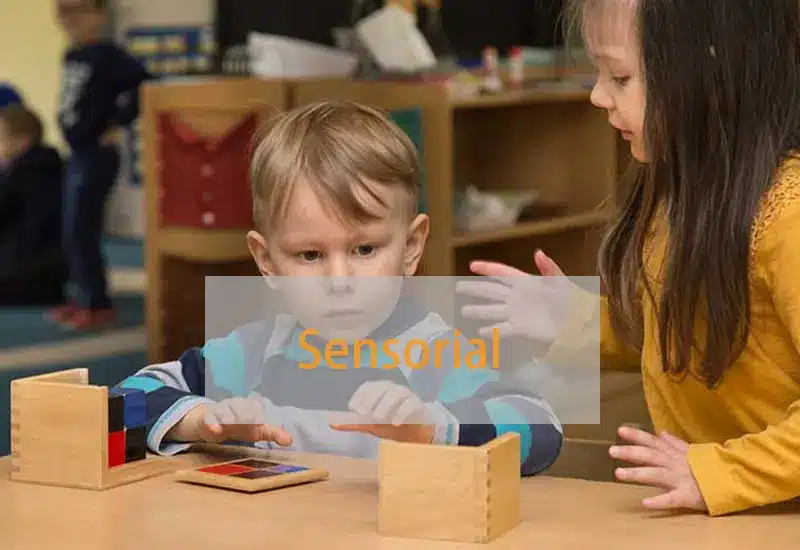
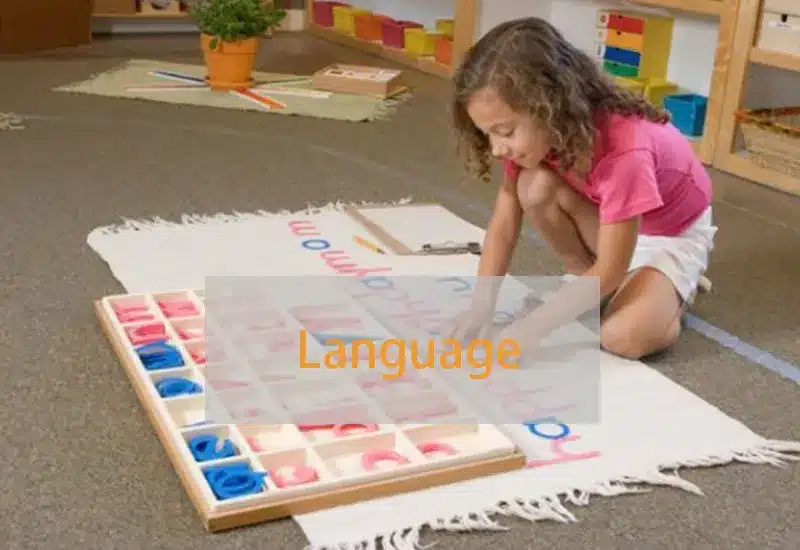
Language
Vocabulary enrichment and literacy aids. From simple matching games that associate objects with their names to more complex materials, materials like the Moveable Alphabet build literacy skills by combining visual, tactile and auditory learning experiences.
Mathematics
The Mathematics materials uniquely abstract complex concepts like numbers, operations, and their relationships into physical forms that children can manipulate. This category includes tools such as bead chains for counting and decimal system materials for understanding place value.
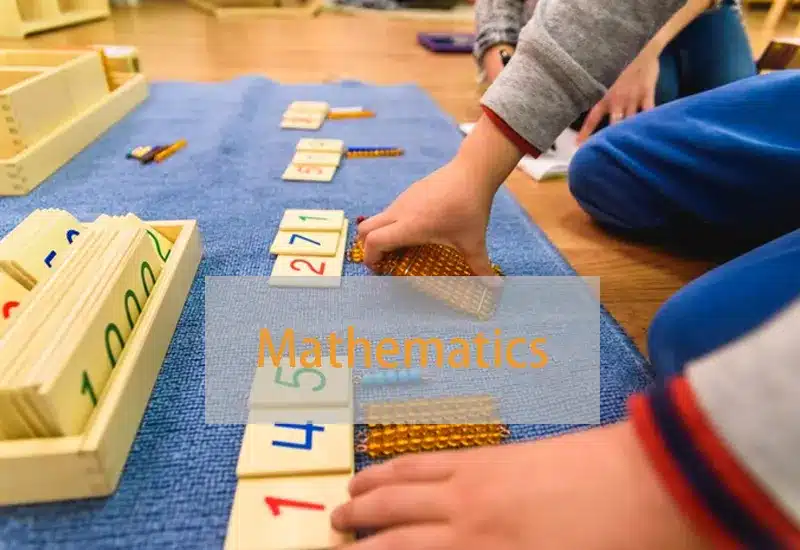
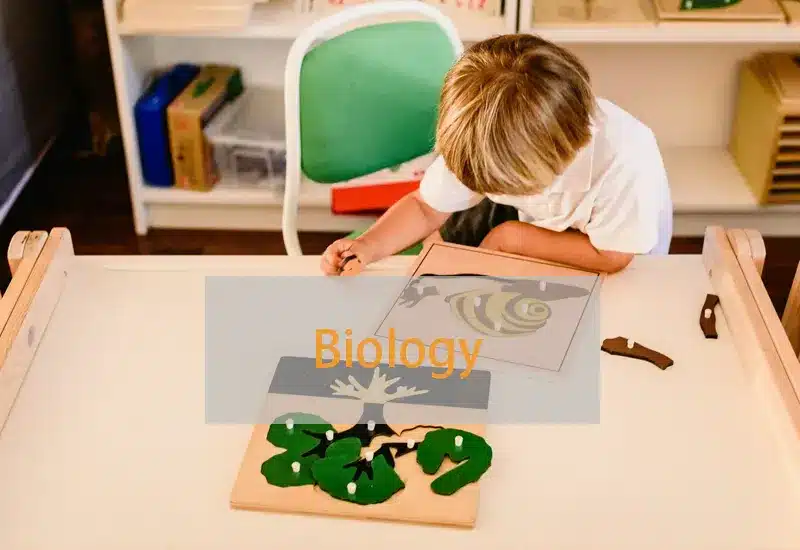
Biology
Specimens, life cycle puzzles, and botanical models introduce children to the sciences of living organisms, enhancing their understanding of life and natural processes.
Geography
Tools like puzzle maps for each continent and landmark cards allow children to explore different regions’ physical layouts and cultural, political, and ecological aspects.
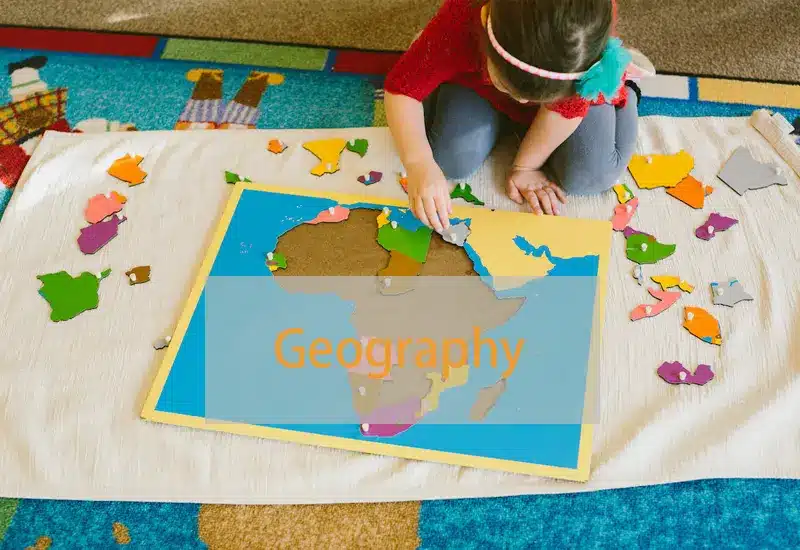
Each material type supports specific developmental needs, ensuring that children learn academic skills and develop socially, emotionally, and physically.
How to Get the Most out of Classic Montessori Materials?
Maximizing the effectiveness of Montessori materials involves understanding their purpose and integrating them seamlessly into the learning environment. Whether at home or in school, these materials should be part of a broader Montessori approach that respects each child’s learning pace and style.
- Structured Environment: Montessori materials work best in a prepared environment where each item has its place and the child can choose what to work on. This setup encourages independence and decision-making.
- Sequential Introduction: Introduce materials progressively according to the child’s developmental stage and previous mastery. This ensures that the child remains challenged but not overwhelmed.
- Integration with Daily Activities: Incorporate materials into daily activities to make learning continuous and consistent. For instance, use practical life tools during regular household tasks.
- Observation: Continuously observe the child to understand their needs and interests. Tailor the use of materials to those observations to keep the child engaged and to reinforce spontaneous learning.
- Repetition and Routine: Encourage repetition to master the skills each material teaches. Repetition solidifies learning and boosts confidence.
- Teacher/Facilitator Role: They should act as a facilitator rather than a direct instructor, guiding the child through the learning process subtly and allowing them to discover and learn independently.
Factors to Consider When Choosing Classic Montessori Materials
Selecting the suitable Montessori materials is crucial for effective learning. Consider the following factors to ensure you choose the best tools for your educational settings:
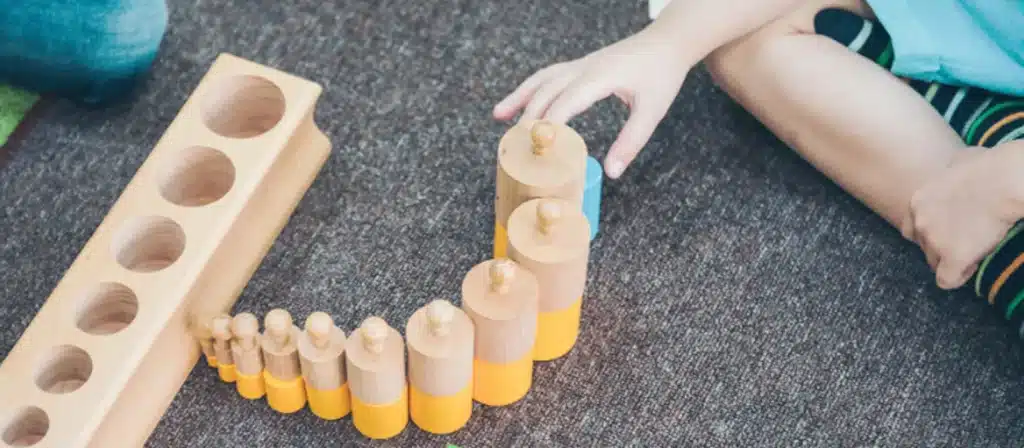
- Age Appropriateness: Each Montessori material is designed for a specific age group based on developmental stages. Select materials that match the age and capability of the children using them.
- Material Quality: High-quality, durable materials ensure safety and longevity. They also offer a more aesthetic appeal, which Maria Montessori emphasized as necessary for children’s learning environments.
- Educational Value: Consider what skills and knowledge the material is designed to develop. Choose materials that offer a range of learning opportunities and cater to different developmental areas.
- Adaptability and Versatility: Some materials have multiple uses and can be adapted for different age groups or learning stages. These are particularly valuable as they grow with the child.
- Cultural and Personal Relevance: Materials should reflect the cultural and personal background of the children to make learning more relevant and engaging.
- Safety: Ensure all materials are non-toxic, have no sharp edges, and are appropriately sized to avoid choking hazards.
Using Montessori Materials at Home or School
Using Montessori materials at home or in school can significantly enhance a child’s learning experience. Here are some tips for both scenarios:
At Home
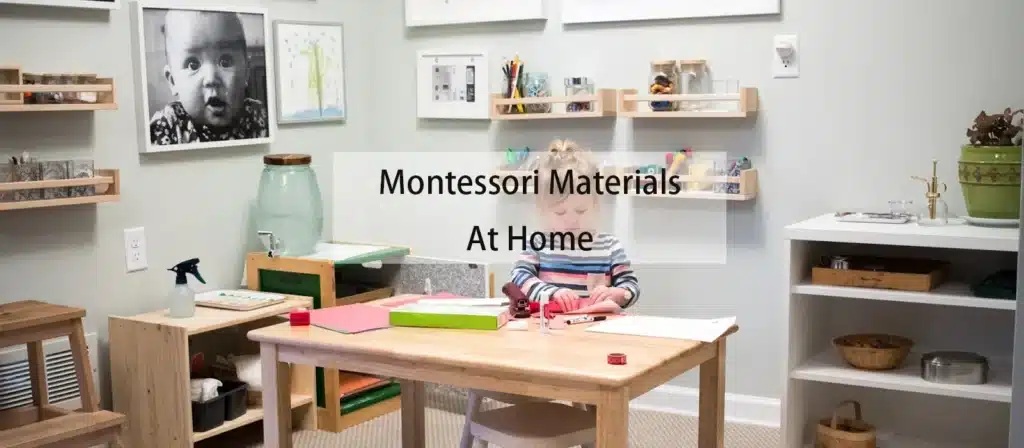
- Create a Dedicated Space: Set up a specific area at home that mimics a Montessori environment with low shelves and accessible materials.
- Routine: Incorporate Montessori activities into the daily routine, allowing children to choose what they want to work on from available options.
- Involvement in Daily Tasks: Using practical life materials, including children in everyday tasks. This helps them learn life skills and enhances their motor development and sense of responsibility.
In School
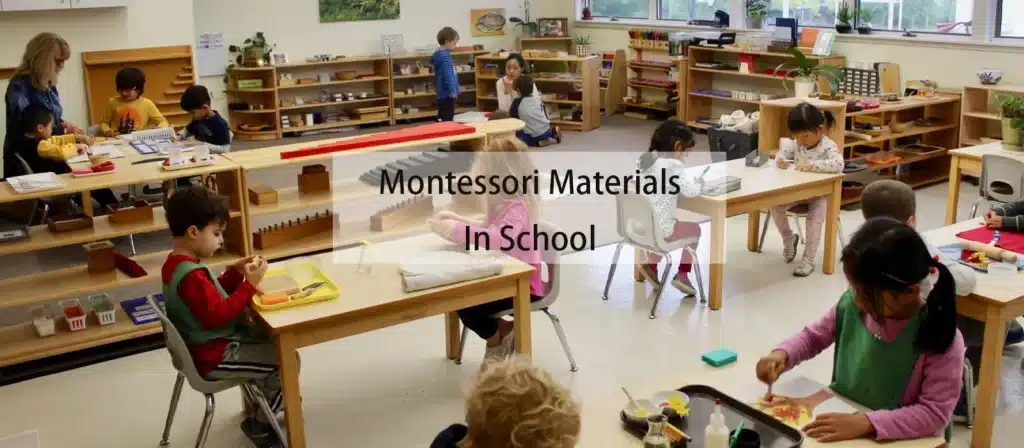
- Collaborative Learning: Encourage group activities using Montessori materials to promote social skills and cooperative learning.
- Curriculum Integration: Integrate materials seamlessly into the broader curriculum to enhance academic and practical education.
- Teacher Training: Ensure educators are well-trained in Montessori philosophies and techniques to guide and observe students effectively.
Where to Buy Montessori Materials
Purchasing genuine and high-quality Montessori materials can be challenging. Here are some tips to find the best sources:
- Specialized Montessori Suppliers: Look for suppliers specializing in Montessori materials. , such as Xiha Montessori. They understand the nuances of Montessori teaching and often provide materials that strictly adhere to Montessori specifications.
- Online Marketplaces: Websites like Amazon and eBay can offer a variety of materials. Read reviews and check seller ratings to ensure quality and authenticity.
- Local Education Stores: Some educational supply stores carry Montessori materials. Visiting these stores allows you to inspect the materials firsthand.
- Montessori School Sales: Some Montessori schools sell or donate their used materials. This can be a cost-effective way to acquire genuine materials.
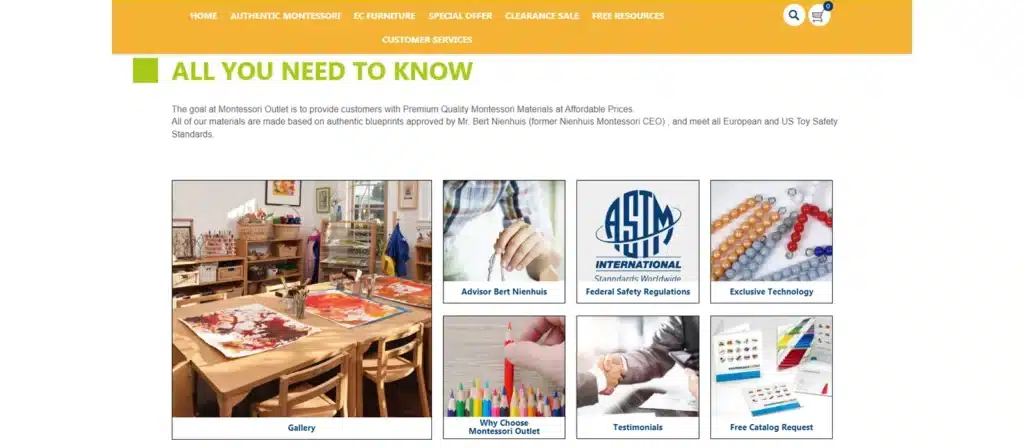
- Brand name: Montessori Outlet
- Location: U.S.
- Company type: Educational Materials Supplier
Montessori Outlet specializes in offering a wide range of high-quality, authentic Montessori materials designed to support the educational development of children. With products catering to the entire Montessori curriculum, the company is committed to making Montessori education accessible to a broad audience, including schools, educators, and parents. Renowned for its competitive pricing and extensive selection, Montessori Outlet is a go-to source for those looking to enrich the learning environments of young learners with genuine Montessori tools.
2. Kid Advance

- Brand Name: Kid Advance Montessori
- Location: Los Angeles, California, USA
- Company Type: Educational Supplies Manufacturer and Retailer
- Year Founded: 2006
- Number of Employees: Approximately 50
Kid Advance Montessori specializes in providing high-quality, affordable Montessori materials to educators, schools, and parents. With a focus on authenticity and durability, our products are designed to support the Montessori method of education, encouraging hands-on, self-directed learning. We pride ourselves on our customer service and commitment to the Montessori educational community.
3. Nienhuis
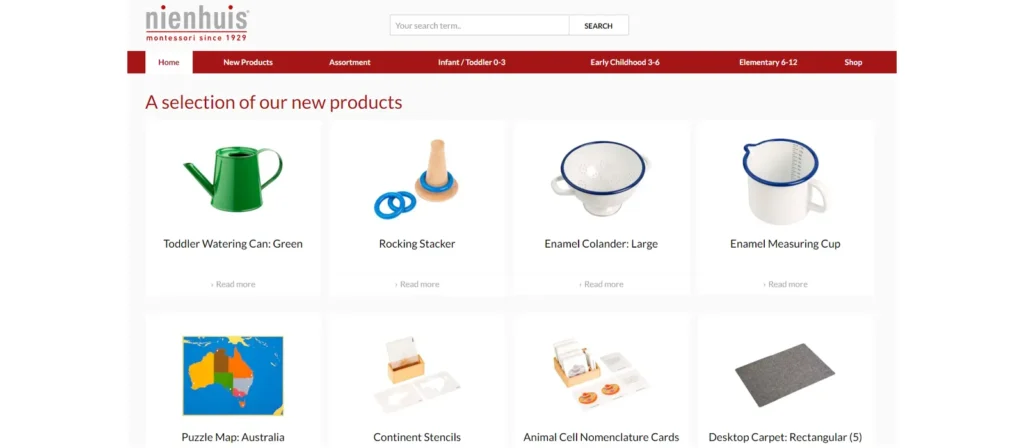
- Brand name: Nienhuis Montessori
- Location: The Netherlands
- Company type: Educational Materials Manufacturer
- Year founded: 1929
- Company Strength Description: Nienhuis Montessori is globally recognized for crafting high-quality, authentic Montessori materials that adhere strictly to the guidelines set by Maria Montessori. Focusing on sustainability and educational efficacy, Nienhuis combines traditional craftsmanship with modern manufacturing techniques to produce materials that enrich Montessori classrooms worldwide.
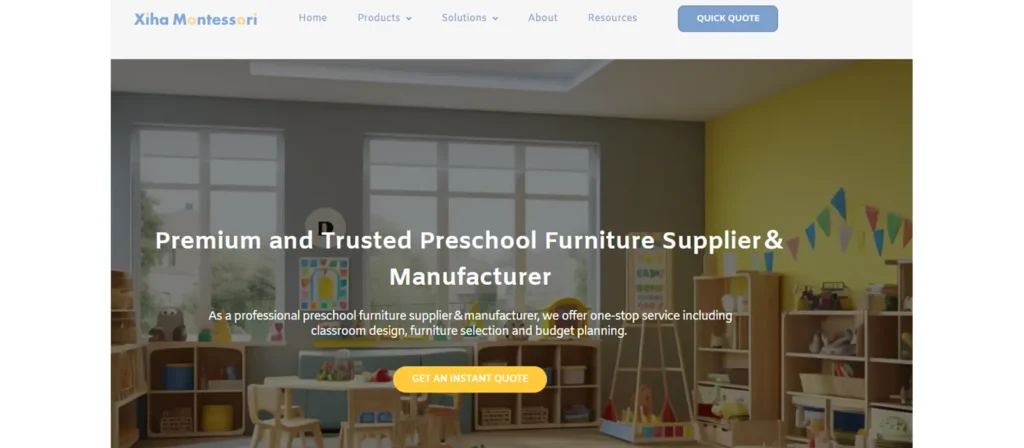
- Location: Dalian, Liaoning
- Company type: Manufacturing, wholesale
- Year founded: 2003
- Number of employees: 250 People
Xiha Montessori’s range of Montessori Materials is impressive, especially considering they are China’s own factories. Their offerings are cost-effective and boast high quality, making them an attractive choice for budget-conscious yet quality-focused settings.

